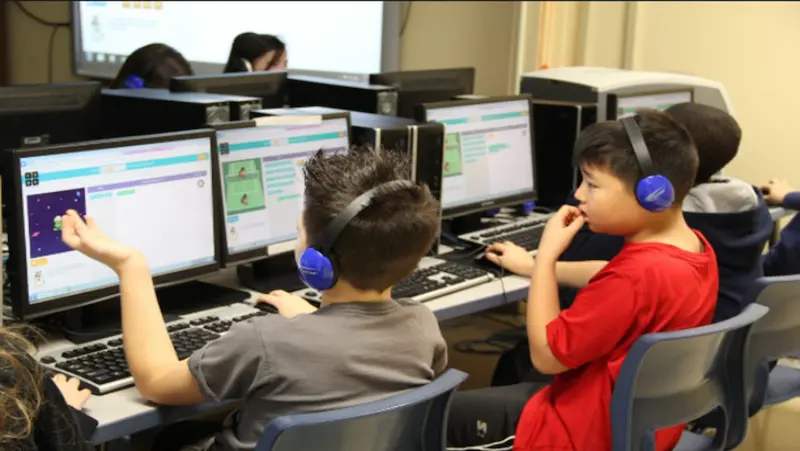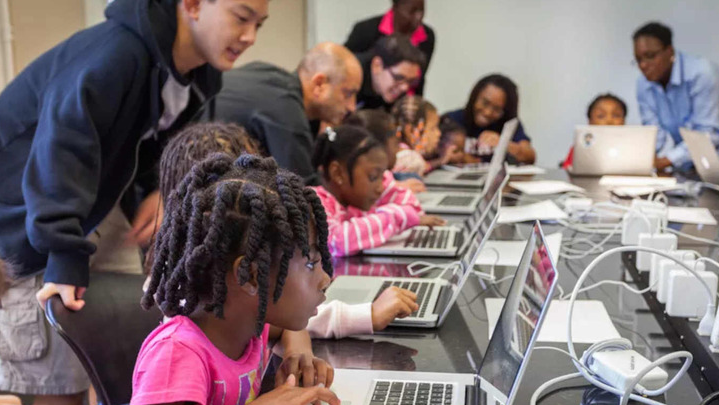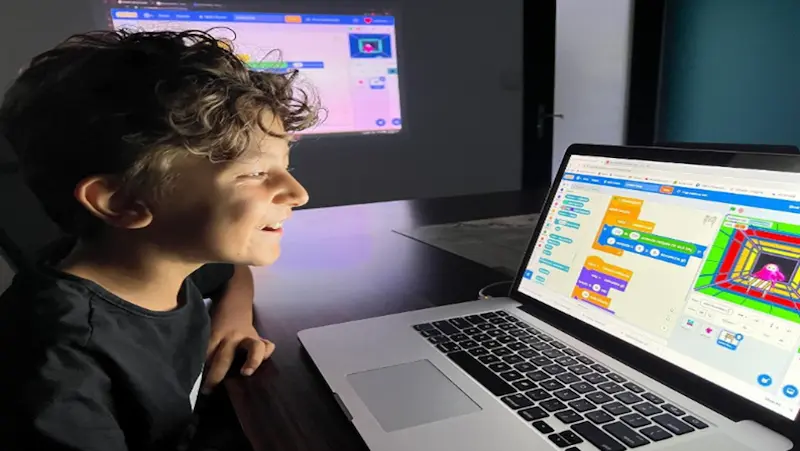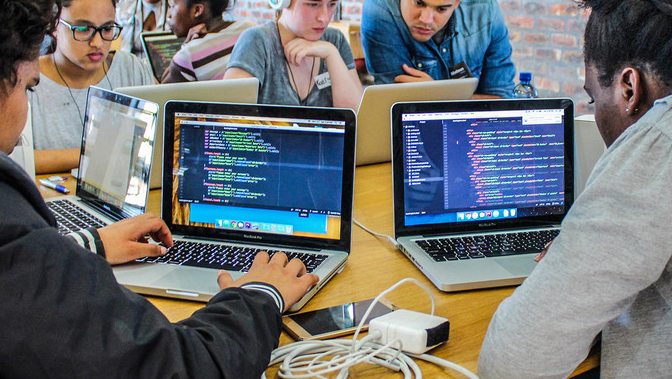Welcome to “A Comprehensive Guide to Finding the Best Coding Class for Kids”! In today’s rapidly evolving world, coding skills have become essential for success in various fields. As a parent or guardian, you may be searching for the perfect coding class to nurture your child’s interest and potential in programming.
This guide aims to assist you in making an informed decision by providing valuable insights and practical tips to help you find the best coding class that suits your child’s needs, interests, and learning style. Let’s embark on this exciting journey together and pave the way for your child’s future in the world of coding!
Table of contents
Introduction

In an ever-evolving world driven by technology and innovation, a solid foundation in STEM (Science, Technology, Engineering, and Mathematics) education has become increasingly crucial for a child’s future success.
STEM education goes beyond teaching specific subjects; it fosters critical thinking, problem-solving skills, and a deep understanding of the world we live in. In this blog section, we will explore the significance of STEM education in a child’s life and how it prepares them for the challenges of the 21st century.
1. Building a Strong Foundation:
STEM education provides children with a solid foundation in core subjects such as mathematics and science. These subjects form the basis for a wide range of future careers and academic pursuits.
By instilling a deep understanding of these subjects from an early age, children are better equipped to tackle more complex concepts as they progress in their education.
2. Developing Critical Thinking and Problem-Solving Skills:
One of the key benefits of STEM education is its emphasis on critical thinking and problem-solving skills. Through hands-on experiments, projects, and real-world applications, children learn how to approach challenges analytically, think creatively, and find innovative solutions.
These skills are not only essential for STEM-related fields but are also transferable to various aspects of life.
3. Encouraging Curiosity and Inquiry:
STEM education nurtures children’s innate curiosity and encourages them to ask questions, explore, and seek answers. By engaging in hands-on activities and experiments, children learn to become active learners, discovering the world around them through their own observations and experiences. This curiosity-driven approach cultivates a lifelong love for learning and exploration.
4. Fostering Collaboration and Teamwork:
STEM education often involves collaborative projects and group activities, which promote teamwork and effective communication skills. In today’s interconnected world, the ability to work collaboratively with diverse individuals is essential. You can also try stem activities for elementary students.
STEM education helps children develop these skills by engaging them in group discussions, and encouraging them to share ideas, and fostering a supportive learning environment.
5. Preparing for Future Careers:
STEM-related careers are on the rise and are projected to continue growing in the coming years. By providing children with a strong STEM education, we equip them with the skills and knowledge necessary to pursue these opportunities.
Additionally, even if a child does not pursue a STEM career, the problem-solving, critical thinking, and analytical skills gained from STEM education are valuable in almost any profession.
Why Coding is a Must-Have Skill for Kids

With the rapid advancements in artificial intelligence, automation, and data analytics, the demand for individuals proficient in coding has skyrocketed. In this blog section, we will delve into the reasons behind the increasing demand for coding skills in the job market and explore how this trend is reshaping career opportunities for individuals worldwide.
Automation and technological advancements:
The digital revolution has completely changed how we communicate, work, and conduct business. Automation is now a fundamental approach for businesses looking to boost productivity and efficiency.
Coding is essential for automating procedures and creating innovative solutions, from software creation to data analysis. As a result, there is an increasing demand for people with coding expertise to create, maintain, and enhance these automated systems.
Expansion of the Tech Sector:
Over the past ten years, the tech sector has experienced exponential expansion. Technology is being incorporated into business operations by startups, well-established corporations, and even conventional industries.
The need for knowledgeable coders has increased across mobile applications and e-commerce platforms. In order to drive innovation and develop game-changing solutions, emerging technologies like artificial intelligence, machine learning, and blockchain demand coding expertise.
Versatility and Transferability:
Coding abilities are extremely adaptable and applicable to a variety of different fields. Despite the huge demand for coders in the technology industry, numerous non-tech fields are also looking for qualified candidates.
Coding is being used in industries like finance, healthcare, marketing, and even the arts to improve consumer experiences and expedite procedures. In addition to expanding career options, having coding abilities gives them the flexibility to adjust to a job market that is changing quickly.
Competitive Advantage:
Having coding abilities can give someone a considerable competitive edge in a job market that is oversaturated with talented applicants. Technically skilled applicants are valued by employers because they display problem-solving aptitude, logical thought, and comprehension of intricate systems.
Job seekers can stand out from the competition and land sought-after employment with greater salaries and better career possibilities by showing their coding talents.
Remote Work and Freelancing Opportunities:
The growth of the gig economy and opportunities for remote work has increased the demand for programmers with coding expertise. Organizations are increasingly turning to remote teams and independent contractors for their coding requirements as technology makes it possible to work from anywhere.
The ability to work on projects for clients globally and benefit from the flexibility of remote work has opened up a world of opportunity for people with coding experience.
Types of Coding Classes for Kids

As technology continues to advance, coding classes for children have gained immense popularity as a way to nurture their creativity, problem-solving abilities, and logical thinking. If you’re a parent or guardian interested in enrolling your child in a coding class, you’ll find a wide range of options available.
In this blog post, we’ll discuss some of the different types of coding classes tailored specifically for children, highlighting their unique features and benefits.
Online coding classes:
Online coding classes have gained significant traction in recent years due to their flexibility and accessibility. Children can learn to code from the comfort of their homes thanks to the easy learning environments provided by these classes.
They frequently include coding challenges, interactive video training, and live tutoring from instructors or mentors. Online coding courses often provide a defined curriculum and cater to a range of ages and skill levels.
Coding Camps:
Coding camps are immersive programs that provide kids with a thorough introduction to programming. These camps offer an intense learning environment and are typically hosted during the summer or during school breaks. Children participate in interactive workshops, group projects, and hands-on coding projects.
Coding boot camps frequently concentrate on certain programming languages or coding disciplines, such as game development, web design, or robotics. They give kids a chance to delve deeply into coding while encouraging cooperation and problem-solving abilities.
Coding Clubs:
Coding clubs provide a social and collaborative learning environment for children interested in coding. These clubs are often set up in schools, community centers, or libraries and give kids the chance to socialize with other kids who are also interested in coding.
Coding challenges, cooperative projects, and contests are frequent features of coding clubs. They establish a sense of community among young programmers while encouraging teamwork, communication, and critical thinking abilities.
Mobile App Development Classes:
In an era dominated by smartphones and tablets, mobile app development has become a sought-after skill. Children are taught how to design their own mobile applications in mobile app development classes.
These classes frequently use drag-and-drop or visual programming interfaces, which makes it simpler for kids to understand coding concepts. Children learn to think creatively, create user interfaces, and hone their problem-solving abilities through mobile app development programs.
Robotics and electronics classes:
Robotics for kids and electronics classes combine coding for kids with hands-on activities, allowing children to build and program robots or electronic devices. Along with coding, these seminars frequently cover engineering, mechanical, and circuit fundamentals.
Children gain knowledge of logical thinking, problem-solving, and the value of accuracy in coding through working on robotics projects. These classes encourage kids to explore STEM fields and foster their love of technology.
What to Look for in a Coding Class for Kids

As a parent, you may recognize the importance of introducing your child to coding at an early age. But with numerous coding classes and programs available, how do you choose the right one for your child? In this blog post, we will discuss the essential factors to consider when selecting a coding class for your child.
Age Range:
The age range of the program should be your first priority when selecting a coding class for your child. Finding a coding program that complements your child’s developmental stage is crucial because coding lessons are often created to appeal to specific age groups.
Classes that emphasize visual programming or block-based coding may be beneficial for younger students, whereas text-based coding languages may be more appropriate for older students.
Curriculum:
The effectiveness of the program is greatly influenced by the coding curriculum for kids. Look for programs that offer a thorough and well-structured curriculum that gets harder as your child gets better.
Basic programming ideas, problem-solving techniques, and project-based learning should all be included in a solid coding course.
Teacher qualifications:
It is crucial that the teachers or instructors guiding the coding class are qualified and experienced. Strong expertise in computer science or a similar discipline, as well as previous experience dealing with children, are ideal qualifications for instructors.
In addition to having coding experience, look for schools where the instructors can successfully explain difficult subjects to younger students.
Class Size and Individual Attention:
Take into account the size of the class and the amount of one-on-one time given to each student. More individualized attention and interaction between the teacher and students are frequently made possible by smaller class numbers.
As a result, it may be easier for kids to ask questions, get answers to their inquiries, and get constructive criticism on their learning.
Learning Environment:
Your child’s journey into coding can be greatly impacted by their learning environment. Visit the real venue where the coding classes are offered or look around the online platform.
Make sure that there are enough resources and modern technologies to make the environment favorable to learning. Additionally, a welcoming environment might boost your child’s interest in and enjoyment of the computer science course.
Flexibility and Schedule:
Take into account the coding class’s flexibility and timetable. Check to see if the class times fit your child’s schedule and other commitments. Some coding courses include alternatives for both in-person and online instruction, giving students the flexibility to fit their schedules and learning preferences.
Popular Coding Languages and Platforms for Kids

To make the coding journey fun and engaging, numerous languages and platforms have been specifically designed for children. In this blog post, we will introduce some of the most popular coding languages and platforms for children, highlighting their pros and cons to help parents and educators make informed choices.
1. BrightCHAMPS:
CodeChamps by BrightChamps is an extraordinary platform that ignites young minds with the power of coding. It is a creative wonderland where kids dive into the captivating world of programming, learning to unravel complex algorithms and craft their own digital masterpieces.
With a holistic curriculum, CodeChamps nurtures the innate problem-solving abilities of children, fostering their creativity and critical thinking. CodeChamps is where dreams come alive, and the future of innovation takes flight.
2. Scratch:
Scratch coding for kids is a visual programming language developed by the Lifelong Kindergarten Group at the MIT Media Lab. It provides a drag-and-drop interface that allows children to create interactive stories, games, and animations. Scratch offers a playful and intuitive environment, making it an excellent choice for beginners.
Pros:
- User-friendly interface with colorful blocks and intuitive drag-and-drop functionality.
- Large online community and extensive library of projects for inspiration and collaboration.
- Encourages creativity, logical thinking, and problem-solving skills.
Cons:
- Limited to visual programming, may not provide a direct transition to text-based languages.
- May require adult guidance for more complex projects.
- Projects can be limited in scale and performance due to the graphical nature of the language.
3. Python:
Python for kids is a versatile and widely used programming language that is also suitable for children. Known for its simplicity and readability, Python enables young learners to write text-based code and build real-world applications. Its popularity stems from its accessibility and extensive range of libraries.
Pros:
- Clean and readable syntax, making it easier for children to understand and write code.
- Vast library ecosystem, providing access to various functionalities.
- Suitable for both beginner projects and more advanced applications.
Cons:
- Can be more challenging for younger children due to the need for text-based coding.
- Requires a proper development environment setup, which may be daunting for beginners.
- Some concepts, such as data types and loops, may require additional explanation.
4. Minecraft: Education Edition:
Minecraft, the widely popular sandbox game, offers an educational version known as Minecraft: Education Edition. It combines the joy of gaming with coding, allowing children to build and explore their own virtual worlds while learning fundamental programming concepts.
Pros:
- Familiar and engaging platform that appeals to children’s interests.
- Encourages collaborative problem-solving and creativity.
- Integration of coding through “Code Builder” feature, enabling children to learn while playing.
Cons:
- Requires a Minecraft: Education Edition subscription or access through educational institutions.
- Coding is specific to the Minecraft environment and may not directly translate to other languages.
- Limited depth in terms of complex programming concepts.
5. App Inventor:
- App Inventor, developed by MIT, provides a simplified platform for children to create their own mobile applications. It utilizes a block-based programming approach similar to Scratch, enabling young coders to build functional Android apps without prior programming knowledge.
Pros:
- Allows children to design and create their own apps for smartphones and tablets.
- Provides a visual and interactive coding environment.
- Offers real-time testing on Android devices through a wireless connection.
Cons:
- Limited to Android app development, excluding other platforms.
- May require additional guidance to understand more advanced programming concepts.
- Limited support for complex app features.
Benefits of Online Coding Classes

In recent years, the demand for coding skills has skyrocketed, making it a highly sought-after skill set in various industries. As a result, more and more people are turning to online coding classes as a convenient and flexible way to learn programming.
In this blog section, we will delve into the advantages of online coding classes and how they can benefit aspiring coders.
Flexibility and Convenience:
The flexibility that online coding programs provide is one of their main benefits. Online classes, in contrast to traditional classroom settings, give students access to course materials and lectures from any location with an internet connection at any time.
For people with demanding schedules, working professionals, or students who wish to study coding in addition to their usual coursework, this flexibility is especially useful.
Personalized Learning Experience:
Online coding courses frequently offer personalized learning experiences that are catered to individual needs. These programs typically come at a variety of degrees of difficulty, allowing students to pick the one that best suits their knowledge and abilities.
The curriculum is modified based on the learner’s progress in adaptive learning approaches, which are frequently used by online platforms. This guarantees that the learners receive focused instruction and challenges.
Diverse Resources for Learning:
Online coding courses often offer a range of learning materials that go beyond conventional textbooks. Students have access to video lectures, interactive coding challenges, real-world projects, interactive coding exercises, and online communities where they can work with other students and teachers.
This varied collection of tools facilitates a deeper knowledge of coding principles and enriches the educational experience.
Cost-Effectiveness:
Online coding courses are frequently less expensive than conventional in-person coding classes. Since students may access the resources from the convenience of their own homes, they do away with the necessity for transportation or relocation costs.
Additionally, a large range of online platforms provides different pricing alternatives, such as free courses or inexpensive subscription models, making coding instruction more accessible.
Learning at Your Own Speed:
In a traditional classroom setting, students frequently need to adhere to a rigid schedule and keep up with the instructor’s speed. Learning to code online gives students the option to study at their own speed, practice coding assignments, and understand challenging ideas without feeling rushed.
This adaptability guarantees a greater comprehension of the material and enables students to advance at a rate that fits their preferred learning method.
Access to Expert educators:
Online coding classes frequently include subject-matter experts from the industry and seasoned educators. Through various communication channels, such as live chat, discussion forums, or email, these instructors are typically accessible for advice and support.
By having access to qualified teachers, students may get clarification, ask questions, and get helpful comments, which promotes a positive learning environment.
How to Support Your Child’s Coding Journey at Home

As a parent, you have the power to support and encourage your child’s coding education, even if you have little to no coding experience yourself. By providing access to coding resources and tools, you can help cultivate their interest and create a nurturing environment for their growth. In this blog section, we will explore various ways parents can actively contribute to their child’s coding journey at home.
Develop a Basic Understanding of Coding:
In order to properly support your child’s coding education, it is crucial to gain a fundamental knowledge of coding ideas and programming languages.
With this information, you’ll be able to have intelligent conversations and offer assistance when it’s required. Investigate online guides, coding classes, or even beginner-friendly coding workshops. By doing this, you may educate your child alongside them, making learning a fun and collaborative process.
Provide Access to Coding Resources:
The first step in creating an environment that supports your child’s coding education is giving your child easy access to coding resources. For young learners, there are several platforms, websites, and apps available.
Scratch, Code.org, Khan Academy, and MIT App Inventor are a few well-liked choices. These platforms provide interactive and interesting coding challenges, projects, and tutorials that are appropriate for users of all ages and ability levels.
Invest in Coding Tools and Equipment:
To improve your child’s experience learning to code, think about making a coding tool and equipment investment. Although not required, having access to actual tools can encourage creativity and present chances for practical education.
Your kid may be able to explore real-world applications and bring their code to life with a programmable robot or microcontroller kit, for example. For their coding endeavors, a dependable computer or laptop with the required software and a steady internet connection is also important.
Encourage exploration and personal projects:
Encouraging exploration and personal projects is one of the finest strategies to develop your child’s coding abilities. Give them the time and space they need to tinker, try new things, and follow their interests in coding. Encourage their interest and assist them in coming up with project ideas.
Encourage them to take part in coding contests, sign up for coding communities or clubs, or even work on coding projects with pals. These activities encourage independence, creative problem-solving, and problem-solving skills.
Foster a Growth Mindset:
Encourage a growth mindset because learning to code can be difficult at times, especially for beginners. By stressing that mistakes and failures are worthwhile learning opportunities, you can assist your child in developing a growth attitude.
Educate them on the iterative nature of coding and the importance of perseverance and fortitude. Celebrate all of their successes, no matter how big or small, and remind them that every step they take towards becoming a better programmer is progress.
Be a Helpful Mentor:
As a parent, it is essential that you play the role of a mentor in fostering your child’s interest in learning to code. Be accessible to respond to inquiries, provide direction, and offer insightful criticism. Show real interest in their coding efforts and acknowledge their accomplishments.
Ask them to share their code with you so you may see their development firsthand and offer support. You can arouse their interest in coding and cultivate a lifelong love of learning by getting actively involved, including code class for kids.
Conclusion
In conclusion, enrolling children in coding classes can be a transformative decision for their future prospects in the job market and in life. The world we live in today is driven by technology, and the demand for individuals with coding and programming skills is only growing stronger.
By exposing children to coding at an early age, parents are equipping them with a valuable toolset that will undoubtedly give them a head start in the rapidly evolving job market.
Coding classes not only teach children the fundamentals of programming languages but also instill crucial problem-solving, critical thinking, and logical reasoning skills. These skills are transferable across various domains and are highly sought after by employers in diverse industries.
By engaging in coding classes, children learn how to break down complex problems into manageable parts, fostering a mindset that empowers them to approach challenges with confidence and creativity.
Moreover, coding classes offer children an opportunity to explore their passions and interests. Through coding, they can develop and bring their ideas to life, whether it’s designing a video game, creating a mobile application, or building a website.
This hands-on experience allows children to unleash their creativity and nurtures their entrepreneurial spirit. It cultivates a sense of accomplishment, boosts their self-esteem, and encourages them to embrace innovation and continuous learning.
Beyond the immediate career benefits, coding classes provide children with a broader perspective on the world and its interconnectedness.
They gain an understanding of the digital landscape and how technology impacts various aspects of society. This knowledge empowers them to be active participants in shaping the future and contributing meaningfully to their communities.
In summary, encouraging parents to enroll their children in coding classes is an investment that can yield tremendous long-term benefits. By equipping children with coding skills, parents are providing them with a head start in the job market, empowering them to pursue their passions, fostering critical thinking and problem-solving abilities, and nurturing their creativity and innovation.
In an increasingly digital world, coding education is a gateway to success, opening doors to a wide range of opportunities and enabling children to thrive in both their personal and professional lives.
Frequently Asked Questions
Coding is the process of creating computer programs by writing instructions that computers can understand and execute.
Children as young as 5 or 6 can start learning to code, while older children and teenagers can also benefit from coding education.
Coding classes help kids develop problem-solving skills, logical thinking, creativity, and computational thinking abilities.
Scratch, Python, JavaScript, and Minecraft are popular coding languages and platforms for kids.
Look for coding classes that are age-appropriate, have engaging curriculum, experienced instructors, hands-on projects, and opportunities for creativity.
Yes, online coding classes can be just as effective as in-person classes, providing interactive platforms, real-time feedback, and access to knowledgeable instructors.
Encourage your child to practice coding regularly, provide access to coding resources and tools, and engage in coding projects together.
Yes, learning to code can open up various career opportunities in fields such as software development, data science, web development, and robotics.
The cost of coding classes for kids can vary widely, ranging from free online resources to paid courses, with prices typically ranging from $20 to $100 per session or more.
Yes, coding classes for kids are designed to accommodate beginners, and no prior coding experience is usually required to start learning.

 We are an army of educators and passionate learners from BrightChamps family, committed to providing free learning resources to kids, parents & students.
We are an army of educators and passionate learners from BrightChamps family, committed to providing free learning resources to kids, parents & students.














